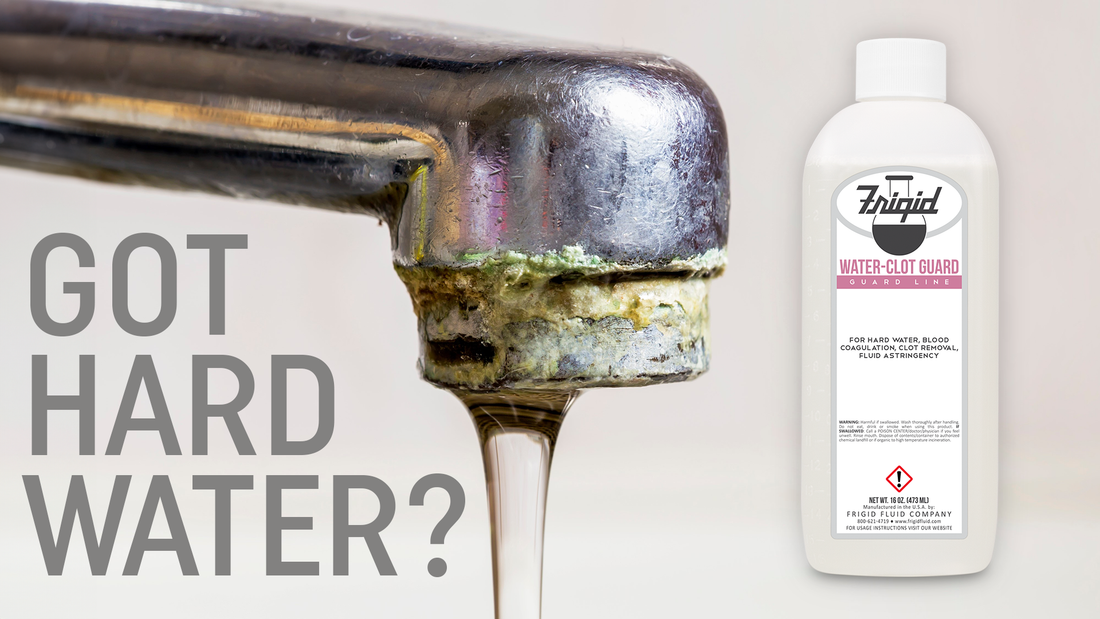Water is an essential resource that sustains life and supports various activities in both households and businesses such as funeral homes. However, not all water is created equal. Some water sources contain high concentrations of dissolved minerals, primarily calcium and magnesium ions, leading to what is commonly known as hard water. It is important to recognize that calcium is responsible for the clotting reaction of blood and can create clots. Metals ions in general can become lodged in cell walls and block capillaries as well, reducing your solutions ability to diffuse properly. Understanding the sources of hard water in your funeral home is crucial for addressing the challenges it presents for embalmers
- Groundwater Sources: A significant portion of the world's water supply comes from groundwater sources, such as wells and boreholes. When rainwater or surface water seeps into the ground, it begins its journey through various rock layers and sediment. Along the way, it interacts with rocks rich in calcium carbonate (limestone) or magnesium compounds (dolomite), leading to the dissolution of these minerals. As a result, the groundwater becomes enriched with calcium and magnesium ions, causing it to be classified as hard water.
- Geological Composition: The geological composition of the region can play a significant role in determining the hardness of water in your area. Some geological formations contain high concentrations of calcium and magnesium-bearing rocks. For instance, areas with limestone, chalk, gypsum, or dolomite formations are more likely to have hard water sources. The top five metro areas in the United States that have hard water are Indianapolis, Las Vegas, Minneapolis, Phoenix, and San Antonio because of their geological composition. The Midwest in general has the highest instance of hardwater. Internationally, the UK, Canada, and Australia all have a high level of water hardness.
- Municipal Water Sources: Even in urban settings, where water is supplied by municipalities, hard water can still be a concern. The water sources tapped by municipal water treatment plants may originate from sources influenced by the local geology, such as underground aquifers or surface water. As a result, the water might naturally contain dissolved minerals, leading to hardness.
- Surface Water Contamination: Surface water, such as water from lakes, rivers, and reservoirs, can also exhibit varying degrees of hardness. The water picks up minerals as it flows over rocks and through soil. In agricultural regions where fertilizers and agricultural runoff are common, the water might contain additional minerals, exacerbating the hardness levels.
- Human Activities: Human activities can contribute to water hardness. Industries discharging wastewater containing minerals can introduce hardness into water sources. Similarly, improper waste disposal, especially in mining and agricultural regions, can lead to mineral leaching into water bodies, increasing water hardness.
- Water Treatment Facilities: Water treatment facilities are responsible for supplying clean and potable water to communities. While they aim to remove harmful substances, they may not always address the minerals responsible for water hardness effectively. In some cases, water treatment processes may not include water softening methods, allowing the minerals to remain in the water supply.
- Plumbing System Contamination: In older funeral homes with aging plumbing systems, metal pipes can corrode over time. This corrosion can introduce trace amounts of metals like calcium and magnesium into the water as it travels through the pipes, adding to water hardness.
- Seasonal Variations: In certain regions, water hardness can vary depending on the season. During the rainy season, water sources may be diluted, leading to lower mineral concentrations. However, during dry periods, water levels may drop, resulting in higher concentrations of dissolved minerals and increased water hardness.
Identifying hard water in your funeral home
- White Deposits: Look for chalky, white mineral deposits on faucets, showerheads, and other surfaces.
- Soap Scum: Increased soap scum buildup in sinks and tubs due to minerals reacting with soap.
- Water Pressure Issues: Decreased water pressure and clogs in pipes caused by mineral blockages.
- Fabric Stains: Dark brown, rusty, green or black stains may appear on linens and fabrics, such as towels, due to mineral presence.
- Lack of foamy soap: Minerals in water prevent soap from foaming up to its full potential, so if you find that the soap you are using to wash descendants’ hair is “flat,” there’s a good chance you have hard water.
Addressing Hard Water in your prep room: While hard water is not harmful to human health, its impact on plumbing systems and appliances can be problematic. The buildup of mineral deposits can clog pipes, reduce water flow, and decrease the efficiency of water heaters and other appliances. This can also be true in your embalming machine, where a hard water situation can be created. If you are an embalmer who prefers to or is required to leave standing water in your machine, the evaporation of the water will leave any particulates behind. If you are not regularly flushing your machine and cleaning the filter, the likelihood of metals build-up in your machine increases. This can be remedied by regularly flushing your machine with Water Clot Guard (1-WATCLOTG) that is designed specifically to isolate and cage calcium to prevent the clotting reaction and the lodging of metallic particles in the tissue. The Frigid Machine (3-EMB03) remedies this issue by having easily removeable filters and a “clean: function which addresses all of the hydraulic system instead of just flushing the hose and pump.
Frigid Fluid offers several options to combat the challenges of hard water during embalming, . Water softeners are popular devices that use ion exchange to replace calcium and magnesium ions with sodium or potassium ions, reducing water hardness. Additionally, filtration systems, reverse osmosis, and chelation methods can be used to mitigate the effects of hard water. All of these will help at the funeral home level. During your embalming, you can add to your solution Water Clot Guard (1-WATCLOTG) to treat the hardness of your funeral home water and Plasma Flo (1-PLASFLO) to combat any clots that may be created or are already existing.
In conclusion, understanding the sources of hard water and recognizing its presence in your home or business is essential not only for maintaining your plumbing systems' health and ensuring the efficient operation of appliances such as your embalming machine, but also to achieving the best embalming possible. By identifying the culprits behind water hardness, you can implement appropriate measures to soften the water during your embalming process and service your families the best way possible.


